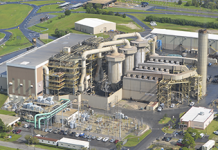by Debra Fiakas CFA
 Just one of the many suppliers of industrial and commercial carbon dioxide, Airgas, Inc. (ARG: NYSE) recently announced plans to build a new carbon dioxide plant in Houston. The press release hit news wires right along with announcements of carbon capture projects and other investments to reduce greenhouse effect from too much CO2 in the atmosphere.
Just one of the many suppliers of industrial and commercial carbon dioxide, Airgas, Inc. (ARG: NYSE) recently announced plans to build a new carbon dioxide plant in Houston. The press release hit news wires right along with announcements of carbon capture projects and other investments to reduce greenhouse effect from too much CO2 in the atmosphere.
In one those strange twists that makes our world so interesting and vexing at the same time, is the fact that we use carbon dioxide all the while we invest wildly to reduce CO2 emissions. An inert gas at normal temperature, carbon dioxide liquefies under high pressure. Carbon dioxide is highly reactive, making it is a handy compound to a wide range of applications such as freezing food, treating alkaline water and facilitating oil recovery that wells. It also finds its way into various products such as fire extinguishers. It is used to de-caffeinate coffee and jazzes up carbonated beverages.
Airgas claims a total of eleven plants for purification and liquefaction of carbon dioxide. Much of the supply goes to Airgas’ dry ice facility also in Texas. Airgas has struck an agreement with oil and gas exploration company Denbury Resources (DNR: NYSE) to deliver raw carbon dioxide to the new Houston plant. The new plant replaces an older plant that is being shuttered this year after the principal supplier of raw carbon dioxide discontinued operations.
There are a variety of sources for carbon dioxide. Besides the CO2 that you and I respire, CO2 results from the combustion of coal or other hydrocarbons. Unfortunately, the concentration of CO2 in ambient air and in stack gases from simple combustion sources such as heaters, boilers, furnaces is not high enough to make carbon dioxide recovery commercially feasible.
Commercially-produced carbon dioxide is principally recovered from large-scale industrial plants which produce hydrogen or ammonia. These sources typically use natural gas, coal or some other hydrocarbon for feedstock. Another carbon dioxide source is large-volume fermentation processes in which plant products are made into ethanol. Breweries producing beer from various grain products are a traditional source. Corn-to-ethanol plants have been the most rapidly growing source of feed gas for CO2 recovery. CO2 is also comingled with oil and gas deposits.
Denbury will be supplying raw carbon dioxide it brings up in its Gulf Coast gas wells. The company claims ownership in every known producing CO2 well in the Gulf Coast region. Denbury also owns CO2 producing wells in the Rocky Mountain region, where it simply re-injects the CO2 back into the geological formation. With demand growing for “injection” CO2 to facilitate extraction of oil and gas from stubborn deposits, Denbury is planning a CO2 capture facility and pipeline at Riley Ridge in the Rocky Mountain region. Denbury says it will require $70 million to complete the initial phase of the CO2 capture facilities at Riley Ridge. The company expects to capture up to 13 million cubic feet per day of CO2.
The required investment for Denbury is a drop in the bucket compared to the hundreds of millions being spent to get CO2 back into the ground. A recent forecast for CO2 prices starts at $0.75 per thousand cubic feet in 2015, and rises to approximately $4.00 per thousand cubic feet in 2030. A separate feasibility study estimated that CO2 from industrial processes or power plants can be captured and transported approximately 100 miles at costs ranging between $1 and $3.50 per thousand cubic feet. It is not hard to understand why carbon capture requires public support.
Airgas trades at 17.5 times estimated earnings for 2013 – a bit of a premium to the industrial chemicals sector. A higher than average profit margin helps set the company apart from the crowd. While Airgas is a major player, others in the industry have larger market share. Debt-to-equity is 110.0% is nearly double the industry average. After the recent run-up in the U.S. equity markets, Airgas appears fully valued. A review of recent trading patterns suggests that Airgas is headed toward $113.00. From the vantage point of the current price level, anyone considering a long position in the stock is well advised to accumulate shares judiciously.
Debra Fiakas is the Managing Director of Crystal Equity Research, an alternative research resource on small capitalization companies in selected industries.
Neither the author of the Small Cap Strategist web log, Crystal Equity Research nor its affiliates have a beneficial interest in the companies mentioned herein.








